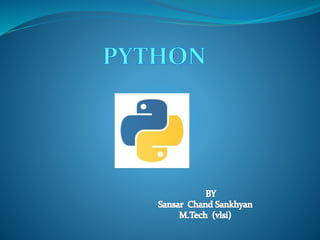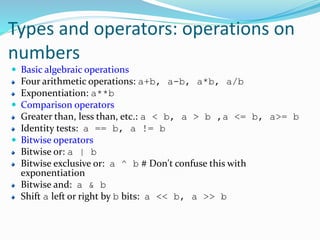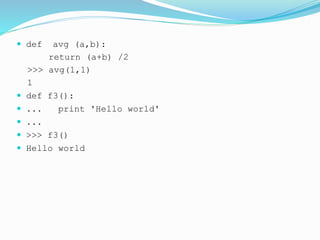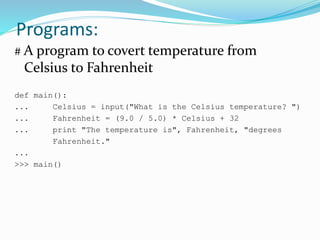scripting in Python
- 2. OUTLINE • Why Use Python? • Running Python • Types and Operators • Basic Statements • Functions • Some programs • Industry applications
- 3. WHY PYTHON? Python is a general-purpose, interpreted high-level programming language It's free (open source) Downloading and installing Python is free and easy Source code is easily accessible Free doesn't mean unsupported! Online Python community is huge It's portable Python runs virtually every major platform used today It just need you to have a compatible Python interpreter installed It's powerful Dynamic typing Built-in types and tools Library utilities Automatic memory management
- 4. Running Python $ python print 'Hello world' Hello world # Relevant output is displayed on subsequent lines without the >>> symbol >>> x = [0,1,2] # Quantities stored in memory are not displayed by default >>> x # If a quantity is stored in memory, typing its name will display it [0,1,2] >>> 2+3 5 >>> # Type ctrl-D to exit the interpreter $
- 5. Suppose the file script.py contains the following lines: print 'Hello world' x = [0,1,2] To execute the script $ python -i script.py Hello world >>> x [0,1,2] >>> # “Hello world” is printed, x is stored and can be called later, and the interpreter is left open >>> import script Hello world >>> script.x [1,2,3]
- 6. Types and operators: operations on numbers Basic algebraic operations Four arithmetic operations: a+b, a-b, a*b, a/b Exponentiation: a**b Comparison operators Greater than, less than, etc.: a < b, a > b ,a <= b, a>= b Identity tests: a == b, a != b Bitwise operators Bitwise or: a | b Bitwise exclusive or: a ^ b # Don't confuse this with exponentiation Bitwise and: a & b Shift a left or right by b bits: a << b, a >> b
- 7. Types and operators: strings and operations Strings are ordered blocks of text Strings are enclosed in single or double quotation marks Examples: 'abc', “ABC” Concatenation and repetition Strings are concatenated with the + sign: >>> 'abc'+'def' 'abcdef' Strings are repeated with the * sign: >>> 'abc'*3 'abcabcabc'
- 8. Indexing and slicing, contd. s[i:j:k] extracts every kth element starting with index i (inclusive) and ending with index j (not inclusive) >>> s[0:5:2] 'srn' Python also supports negative indexes. For example, s[-1] means extract the first element of s from the end. >>> s[-1] 'g‘ >>> s[-2] 'n‘ >>> s.upper() STRING
- 9. Indexing and slicing Python starts indexing at 0. A string s will have indexes running from 0 to len(s)-1 (where len(s) is the length of s) in integer quantities. s[i] fetches the i th element in s >>> s = ‘string' >>> s[1] # note that Python considers 't' the first element 't' # of our string s s[i:j] fetches elements i (inclusive) through j (not inclusive) >>> s[1:4] 'tri' s[:j] fetches all elements up to, but not including j >>> s[:3] 'str' s[i:] fetches all elements from i onward (inclusive) >>> s[2:] 'ring'
- 10. Types and operators: Lists Basic properties: Lists are contained in square brackets [] Lists can contain numbers, strings, nested sublists, or nothing Examples: L1 = [0,1,2,3], L2 = ['zero', 'one'], L3 = [0,1,[2,3],'three',['four,one']], L4 = [] List indexing and slicing works just like string indexing
- 11. Some basic operations on lists: Indexing: L1[i], L2[i][j] Slicing: L3[i:j] Concatenation: >>> L1 = [0,1,2]; L2 = [3,4,5] >>> L1+L2 [0,1,2,3,4,5] Repetition: >>> L1*3 [0,1,2,0,1,2,0,1,2] Appending: >>> L1.append(3) [0,1,2,3] Sorting: >>> L3 = [2,1,4,3] >>> L3.sort()
- 12. More list operations: Reversal: >>> L4 = [4,3,2,1] >>> L4.reverse() >>> L4 [1,2,3,4] Shrinking: >>> del L4[2] Making a list of integers: >>> range(4) [0,1,2,3] >>> range(1,5) [1,2,3,4]
- 13. Types and operators: arrays Similarities between arrays and lists: Arrays and lists are indexed and sliced identically Arrays and lists both have sort and reverse attributes Differences between arrays and lists: With arrays, the + and * signs do not refer to concatenation or repetition Examples: >>> ar1 = array([2,4,6]) >>> ar1+2 # Adding a constant to an array adds the constant to each term [4,6,8,] # in the array >>> ar1*2 # Multiplying an array by a constant multiplies each term in # the array by 2 [4,8,12,]
- 14. Contd: Adding two arrays is just like adding two vectors >>> ar1 = array([2,4,6]); ar2 = array([1,2,3]) >>> ar1+ar2 [3,6,9,] Multiplying two arrays multiplies them term by term: >>> ar1*ar2 [2,8,18,] Same for division: >>> ar1/ar2 [2,2,2,] Assuming the function can take vector arguments, a function acting on an array acts on each term in the array >>> ar2**2 [1,4,9,]
- 15. Basic Statements: The if statement If statements have the following basic structure: # inside the interpreter # inside a script >>> if condition: if condition: ... action action ... >>> 4 spaces >>> x=1 >>> if x< 2: …. Print ‘Hello world’ …. Hello world
- 16. Basic Statements: While statement >>> while x < 4 : …. Print x**2 # square of x …. x = x+1 …. 1 4 9 # sqaure of 4 is not there as 4 is not included
- 17. Basic Statements: For statement For statements have the following basic structure: for item i in set s: action on item i # item and set are not statements here; they are merely intended to clarify the relationships between i and s Example: >>> for i in range(1,7): ... print i, i**2, i**3, i**4 ... 1 1 1 1 2 4 8 16 3 9 27 81 4 16 64 256 5 25 125 625 6 36 216 1296
- 18. Example 2 : >>> L = [0,1,2,3] # or, equivalently, range(4) >>> for i in range(len(L)): ... L[i] = L[i]**2 ... >>> L [0,1,4,9]
- 19. Functions Usually, function definitions have the following basic structure: def func(args): return values >>> def f1(x): ... return x*(x-1) ... >>> f1(3) def f2(x,y): ... return x+y,x-y ... >>> f2(3,2) (5,1)
- 20. def avg (a,b): return (a+b) /2 >>> avg(1,1) 1 def f3(): ... print 'Hello world' ... >>> f3() Hello world
- 21. Note: >>> a = 2 # a is assigned in the interpreter, so it's global >>> def f(x): # x is in the function's argument list, so it's local ... y = x+a # y is only assigned inside the function, so it's local
- 22. Programs: # A program to covert temperature from Celsius to Fahrenheit def main(): ... Celsius = input("What is the Celsius temperature? ") ... Fahrenheit = (9.0 / 5.0) * Celsius + 32 ... print "The temperature is", Fahrenheit, "degrees Fahrenheit." ... >>> main()
- 23. A program to compute the value of an investment carried 10 years into the future vi inv.py def main(): print "This program calculates the future value print "of a 10-year investment." principal = input("Enter the initial principal: ") apr = input("Enter the annual interest rate: ") for i in range(10): principal = principal * (1 + apr) print "The value in 10 years is:", principal $ python –i inv.py >>> main()
- 24. Industry applications: web programming (client and server side) ad hoc programming ("scripting") steering scientific applications extension language database applications GUI applications education
- 25. Who is using it? Google (various projects) NASA (several projects) Industrial Light & Magic (everything) Yahoo! (Yahoo mail & groups) Real Networks (function and load testing) RedHat (Linux installation tools)




![Running Python
$ python
print 'Hello world'
Hello world
# Relevant output is displayed on subsequent lines without the
>>> symbol
>>> x = [0,1,2]
# Quantities stored in memory are not displayed by default
>>> x
# If a quantity is stored in memory, typing its name will display it
[0,1,2]
>>> 2+3
5
>>> # Type ctrl-D to exit the interpreter
$](https://image.slidesharecdn.com/python1-140710074239-phpapp02/85/scripting-in-Python-4-320.jpg)
![ Suppose the file script.py contains the following
lines:
print 'Hello world'
x = [0,1,2]
To execute the script
$ python -i script.py
Hello world
>>> x
[0,1,2]
>>>
# “Hello world” is printed, x is stored and can be called later, and the
interpreter is left open
>>> import script
Hello world
>>> script.x
[1,2,3]](https://image.slidesharecdn.com/python1-140710074239-phpapp02/85/scripting-in-Python-5-320.jpg)


![ Indexing and slicing, contd.
s[i:j:k] extracts every kth element starting with index i
(inclusive) and ending with index j (not inclusive)
>>> s[0:5:2]
'srn'
Python also supports negative indexes. For example, s[-1]
means extract the first element of s from the end.
>>> s[-1]
'g‘
>>> s[-2]
'n‘
>>> s.upper()
STRING](https://image.slidesharecdn.com/python1-140710074239-phpapp02/85/scripting-in-Python-8-320.jpg)
![ Indexing and slicing
Python starts indexing at 0. A string s will have indexes running
from 0 to len(s)-1 (where len(s) is the length of s) in
integer quantities.
s[i] fetches the i th element in s
>>> s = ‘string'
>>> s[1] # note that Python considers 't' the first element
't' # of our string s
s[i:j] fetches elements i (inclusive) through j (not inclusive)
>>> s[1:4]
'tri'
s[:j] fetches all elements up to, but not including j
>>> s[:3]
'str'
s[i:] fetches all elements from i onward (inclusive)
>>> s[2:]
'ring'](https://image.slidesharecdn.com/python1-140710074239-phpapp02/85/scripting-in-Python-9-320.jpg)
![Types and operators: Lists
Basic properties:
Lists are contained in square brackets []
Lists can contain numbers, strings, nested sublists, or nothing
Examples: L1 = [0,1,2,3], L2 = ['zero', 'one'],
L3 = [0,1,[2,3],'three',['four,one']], L4 = []
List indexing and slicing works just like string indexing](https://image.slidesharecdn.com/python1-140710074239-phpapp02/85/scripting-in-Python-10-320.jpg)
![ Some basic operations on lists:
Indexing: L1[i], L2[i][j]
Slicing: L3[i:j]
Concatenation:
>>> L1 = [0,1,2]; L2 = [3,4,5]
>>> L1+L2
[0,1,2,3,4,5]
Repetition:
>>> L1*3
[0,1,2,0,1,2,0,1,2]
Appending:
>>> L1.append(3)
[0,1,2,3]
Sorting:
>>> L3 = [2,1,4,3]
>>> L3.sort()](https://image.slidesharecdn.com/python1-140710074239-phpapp02/85/scripting-in-Python-11-320.jpg)
![ More list operations:
Reversal:
>>> L4 = [4,3,2,1]
>>> L4.reverse()
>>> L4
[1,2,3,4]
Shrinking:
>>> del L4[2]
Making a list of integers:
>>> range(4)
[0,1,2,3]
>>> range(1,5)
[1,2,3,4]](https://image.slidesharecdn.com/python1-140710074239-phpapp02/85/scripting-in-Python-12-320.jpg)
![Types and operators: arrays
Similarities between arrays and lists:
Arrays and lists are indexed and sliced identically
Arrays and lists both have sort and reverse attributes
Differences between arrays and lists:
With arrays, the + and * signs do not refer to concatenation or repetition
Examples:
>>> ar1 = array([2,4,6])
>>> ar1+2 # Adding a constant to an array adds the constant to each
term
[4,6,8,] # in the array
>>> ar1*2 # Multiplying an array by a constant multiplies each term
in # the array by 2
[4,8,12,]](https://image.slidesharecdn.com/python1-140710074239-phpapp02/85/scripting-in-Python-13-320.jpg)
![Contd:
Adding two arrays is just like adding two vectors
>>> ar1 = array([2,4,6]); ar2 = array([1,2,3])
>>> ar1+ar2
[3,6,9,]
Multiplying two arrays multiplies them term by term:
>>> ar1*ar2
[2,8,18,]
Same for division:
>>> ar1/ar2
[2,2,2,]
Assuming the function can take vector arguments, a function
acting on an array acts on each term in the array
>>> ar2**2
[1,4,9,]](https://image.slidesharecdn.com/python1-140710074239-phpapp02/85/scripting-in-Python-14-320.jpg)



![ Example 2 :
>>> L = [0,1,2,3] # or, equivalently, range(4)
>>> for i in range(len(L)):
... L[i] = L[i]**2
...
>>> L
[0,1,4,9]](https://image.slidesharecdn.com/python1-140710074239-phpapp02/85/scripting-in-Python-18-320.jpg)







